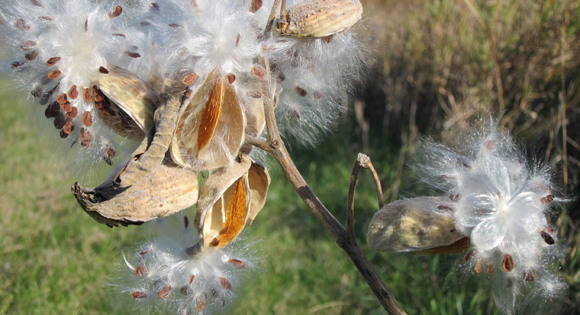
Milkweed pods contain hundreds of brown seeds, each with a silky parachute that carries the seeds away with the wind.
Fall! The obvious things that fall at this time of year are the leaves of deciduous trees and shrubs. The evolutionary advantage for this is to sever the leaves from the tree, which loose lots of water during a time of year when water is less available. Also when the water is frozen in the soil in winter, it cannot be taken up and therefore it is important for the plant to reduce water loss. In contrast, some plants from other parts of the world loose their leaves when it gets too hot in the summer and therefore less water is available. Of course there are other plants such as evergreen conifers, pine and spruce trees, that retain their leaves even when the water supply is frozen. They developed a different strategy for overcoming the drought of winter. Their leaves have antifreeze, and the needles are designed for low water loss.
Interestingly there are some other things that are falling down as well. Seeds are falling all over the place, during this time of year. They are little baby plants with a lunch packed to sustain them over their time of rest and at the time of germination, until their leaves take over the task of supplying food. A lot of seeds do not fall straight down under their mother, where they would have to compete with her in the future, but have devised strategies through evolution for distributing their babies far and wide to increase the chances for success. Some of the seeds are produced in tasty fruit that are eaten by animals of various sorts and thereby carried and deposited far away. Some seeds have developed helicopter-like wings such as maples. Others have wonderfully clever parachutes such as the dandelion, which carry the seeds on the wind. The effectiveness, sophistication and diversity of these strategies for survival are nothing short of divine.
Another thing that is falling at this time of year, but which can’t be easily observed, is the food supply for the plant. For many plants the sugars generated through photosynthesis during the growing season often move down from the leaves and stems to the root system. In trees, some of the sugars stay in the trunk and branches, and act like an antifreeze for the water inside. There have been instances of apple trees bearing such a heavy crop of fruit that there is not enough sugar to provide that antifreeze and the trunk freezes and cracks that winter. In herbaceous perennial plants, such as most of the plants on the prairie, the food moves down into the root system and then the part of the plant above ground freezes and dies. These plants have a root system with lots of buds just at the surface of the soil, ready to grow when water becomes available again in the spring.
Come out to Holy Wisdom Monastery to visit and observe the miracle of life this fall! Walk the nature trails or sit on the benches overlooking the prairie or Lost Lake and feel the peace surround you. Better yet, come for a personal retreat and spend a day or more exploring the land. If you would like to volunteer your time, to help maintain the grounds at Holy Wisdom Monastery, contact Jan at (608) 836-1631 x123.

